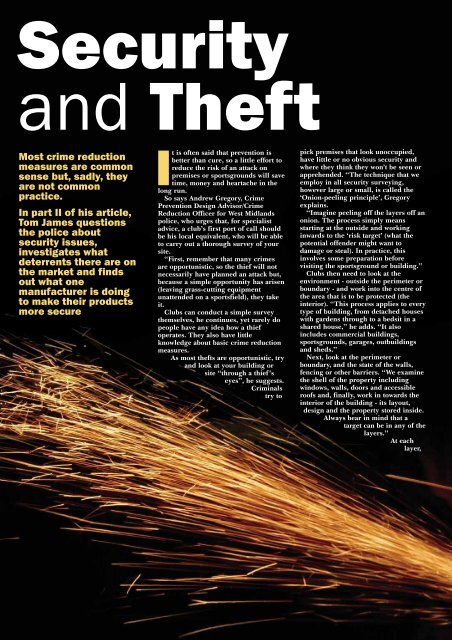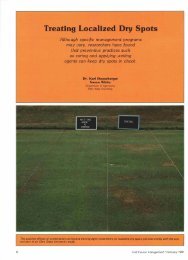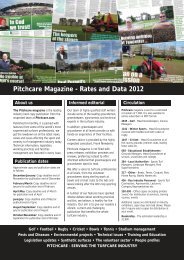Earning his Spurs - Pitchcare
Earning his Spurs - Pitchcare
Earning his Spurs - Pitchcare
Create successful ePaper yourself
Turn your PDF publications into a flip-book with our unique Google optimized e-Paper software.
Security<br />
and Theft<br />
Most crime reduction<br />
measures are common<br />
sense but, sadly, they<br />
are not common<br />
practice.<br />
In part II of <strong>his</strong> article,<br />
Tom James questions<br />
the police about<br />
security issues,<br />
investigates what<br />
deterrents there are on<br />
the market and finds<br />
out what one<br />
manufacturer is doing<br />
to make their products<br />
more secure<br />
It is often said that prevention is<br />
better than cure, so a little effort to<br />
reduce the risk of an attack on<br />
premises or sportsgrounds will save<br />
time, money and heartache in the<br />
long run.<br />
So says Andrew Gregory, Crime<br />
Prevention Design Advisor/Crime<br />
Reduction Officer for West Midlands<br />
police, who urges that, for specialist<br />
advice, a club’s first port of call should<br />
be <strong>his</strong> local equivalent, who will be able<br />
to carry out a thorough survey of your<br />
site.<br />
“First, remember that many crimes<br />
are opportunistic, so the thief will not<br />
necessarily have planned an attack but,<br />
because a simple opportunity has arisen<br />
(leaving grass-cutting equipment<br />
unattended on a sportsfield), they take<br />
it.<br />
Clubs can conduct a simple survey<br />
themselves, he continues, yet rarely do<br />
people have any idea how a thief<br />
operates. They also have little<br />
knowledge about basic crime reduction<br />
measures.<br />
As most thefts are opportunistic, try<br />
and look at your building or<br />
site “through a thief ’s<br />
eyes”, he suggests.<br />
Criminals<br />
try to<br />
pick premises that look unoccupied,<br />
have little or no obvious security and<br />
where they think they won’t be seen or<br />
apprehended. “The technique that we<br />
employ in all security surveying,<br />
however large or small, is called the<br />
‘Onion-peeling principle’, Gregory<br />
explains.<br />
“Imagine peeling off the layers off an<br />
onion. The process simply means<br />
starting at the outside and working<br />
inwards to the ‘risk target’ (what the<br />
potential offender might want to<br />
damage or steal). In practice, t<strong>his</strong><br />
involves some preparation before<br />
visiting the sportsground or building.”<br />
Clubs then need to look at the<br />
environment - outside the perimeter or<br />
boundary - and work into the centre of<br />
the area that is to be protected (the<br />
interior). “T<strong>his</strong> process applies to every<br />
type of building, from detached houses<br />
with gardens through to a bedsit in a<br />
shared house,” he adds. “It also<br />
includes commercial buildings,<br />
sportsgrounds, garages, outbuildings<br />
and sheds.”<br />
Next, look at the perimeter or<br />
boundary, and the state of the walls,<br />
fencing or other barriers. “We examine<br />
the shell of the property including<br />
windows, walls, doors and accessible<br />
roofs and, finally, work in towards the<br />
interior of the building - its layout,<br />
design and the property stored inside.<br />
Always bear in mind that a<br />
target can be in any of the<br />
layers.”<br />
At each<br />
layer,

















